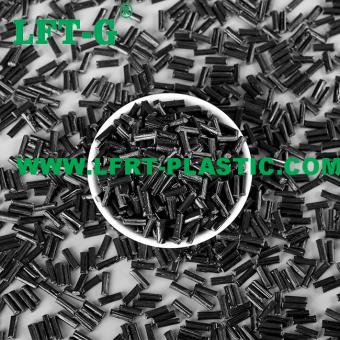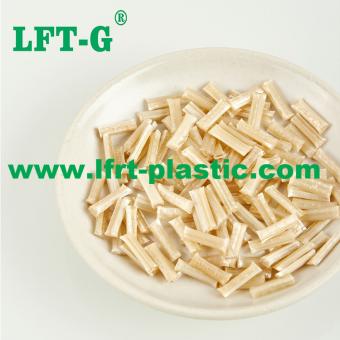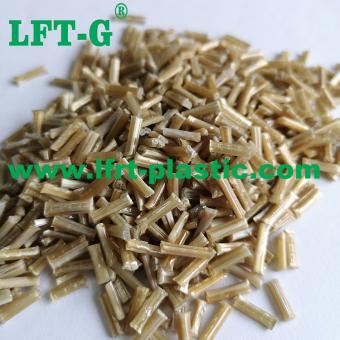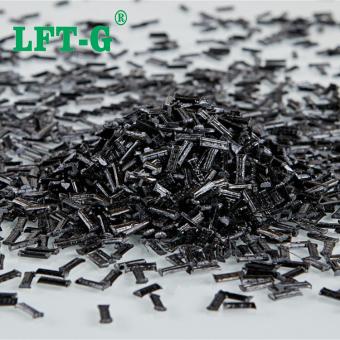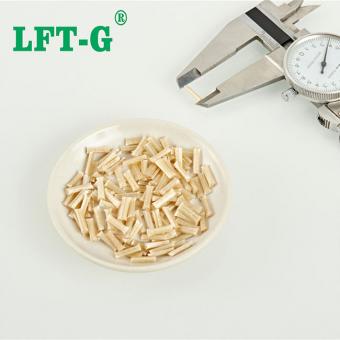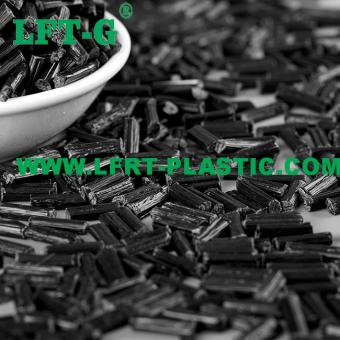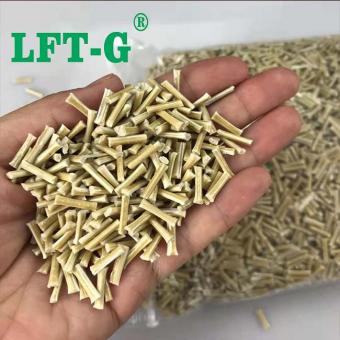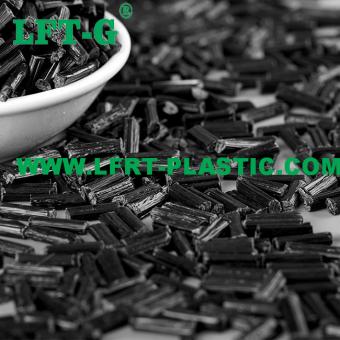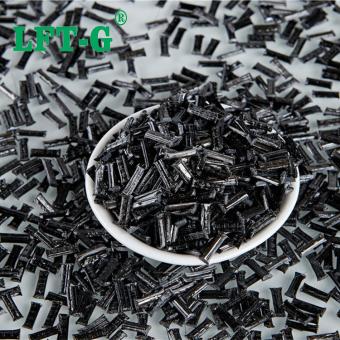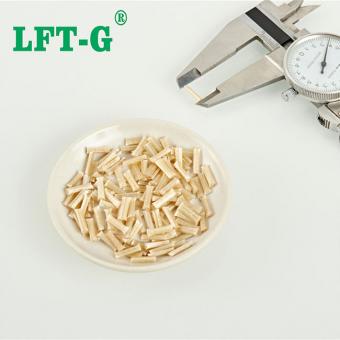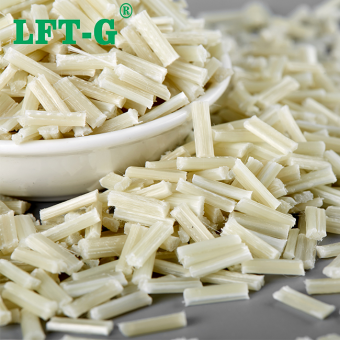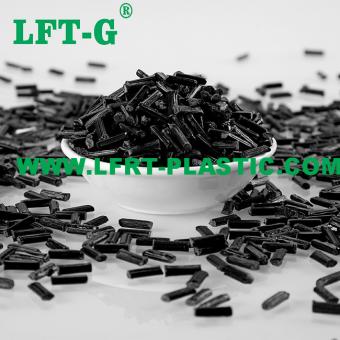-
Polyphenyl sulfide pps filled 30% LCF flame retardant grade UL-94 heat resistancePolyphenylene sulfide is a new functional engineering plastic.
- Polyphenyl sulfide
- PPS plastic
- Composite material
- Filling lcf 30
- High flame retardant
- Factory use raw material
Tags :
-
PPS raw material filled long glass fiber lgf 40% high toughness car parts and other filedWhat is PPS? PPS has a symmetrical rigid backbone and is part of a crystalline polymer consisting of repeated parapplacement of benzene rings and sulfur atoms. PPS are special engineering plastics with high performance, high melting point up to 280℃, which can replace metal. They are located at the top of the polymer property pyramid, as shown in Figure 1. Therefore, based on the excellent performance of PPS resin, make it meet the requirements of harsh engineering plastic projects for materials. Why filling long glass fiber? Long glass fiber reinforced plastic is on the basis of the original pure plastic, adding glass fiber and other additives, so as to improve the scope of use of materials. Advantages: 1. After glass fiber reinforcement, glass fiber is a high temperature resistant material, therefore, the heat resistance temperature of reinforced plastics is much higher than before without glass fiber, especially nylon plastics; 2. After glass fiber reinforcement, due to the addition of glass fiber, limited the mutual movement between polymer chains of plastics, therefore, the shrinkage rate of reinforced plastics decreases a lot, rigidity is greatly improved; 3. After glass fiber reinforcement, the reinforced plastic will not stress crack, at the same time, the anti-impact performance of plastic is improved a lot; 4. After glass fiber reinforcement, glass fiber is a high strength material, which also greatly improves the strength of plastic, such as: tensile strength, compression strength, bending strength, improve a lot; 5. glass fiber reinforced after, due to the addition of glass fiber and other additives, the combustion performance of reinforced plastics decreased a lot, most of the material can not ignite, is a kind of flame retardant material. Datasheets for your reference Performance advantages include the following aspects: excellent heat resistance, good mechanical properties, corrosion resistance, self-flame retardant up to UL94 V-0 level. Because PPS has the advantages of the above properties, and compared with other high performance thermoplastic engineering plastics and has the characteristics of easy processing, low cost, so it becomes an excellent resin matrix for manufacturing composite materials. Details Color Original or as required Length Above 5~24mm MOQ 25kg Package 25kg a bag Port of Loading Xiamen Port Delivery time 7~15 days after shipment
- Polyphenylene sulfide composite
- long glass fiber compound pps
- LFT-G brand plastic
- LGF PPS reinforced material
- Injection grade PPS
- pellets of plastic pps
Tags :
-
LFT-G PPS Polyphenylene sulfide LGF composite long glass fiber customized color engineering plasticsWhat is the PPS? Polyphenylene sulfide (PPS) is a new thermoplastic resin with high performance. By filling, modified with excellent high temperature resistance, corrosion resistance, wear resistance, flame retardant, balanced physical and mechanical properties and excellent dimensional stability and excellent electrical properties and other characteristics of the new high performance thermoplastic resin, as well as high mechanical strength, chemical resistance, flame resistance, good thermal stability, excellent electrical properties and other advantages. It has the advantages of hard and brittle, high crystallinity, inflammability, good thermal stability, high mechanical strength, excellent electrical properties, strong chemical corrosion resistance and so on. The mechanical properties of pure PPS are not high, especially the impact strength is relatively low. Good creep resistance under load, high hardness; High wear resistance, the wear at 1000 RPM is only 0.04g, and will be further improved after filling F4 and molybdenum disulfide; It also has a certain degree of self-moistening. The mechanical properties of PPS are less sensitive to temperature. What is the PPS-LGF? PPS is one of the best varieties of heat resistance in the engineering plastic department. The thermal deformation temperature of the material modified by glass fiber is generally greater than 260 degrees, and the chemical resistance is second only to PTFE. In addition, it also has small shrinkage, low water absorption, good fire resistance. Good resistance to vibration fatigue, strong resistance to arc, especially at high temperature. Excellent electrical insulation in high humidity. But its disadvantages are brittleness, toughness, low impact strength, after modification, can overcome the above shortcomings, obtain very excellent comprehensive performance. As a plastic, its properties and uses far exceed those of ordinary plastics, and in many ways it is as good as metal materials. Excellent material PPS has the advantages of high temperature corrosion resistance, excellent mechanical properties, can replace metal including stainless steel, copper, aluminum, alloy, etc., is considered to be the best substitute for metal, copper. What is the application of PPS-LGF? PPS is now widely used in automotive, aerospace, household appliances, mechanical construction and chemical industry for a variety of structural parts, transmission parts, insulation parts, corrosion resistant parts and seals. Under the condition of ensuring sufficient strength and other properties, the weight of the product is greatly reduced. Datasheet for reference Details Number Color Length MOQ Package Sample Delivery time Port of Loading PPS-NA-LGF30 Original color (can be customized) 5-25mm above 25kg 25kg/bag Available 7-15 days after shipment Xiamen Poer Production process Trademarks and patents Teams and customers We will offer you: 1. LFT & LFRT material technical parameters and leading edge design 2. Mold front design and recommendations 3. Provide technical support such as injection molding and extrusion molding.
- PPS Long glass fiber 40
- pps compounds lgf
- pps resin materials lft
- lft-g pps reinforced plastic
- long glass fiber filling pps
- termoplastic resin pps lgf
Tags :
-
LFT PPS Long Carbon Fiber compoosite material reinforced plastic lcf high toughness for carsPPS-LCF materials Polyphenylene sulfide (PPS) is a linear semi-crystalline polymer with benzene ring and sulfur atoms composed of molecular main chain, its melting point is about 280℃, and has many excellent characteristics, with a series of excellent properties, such as excellent mechanical properties, chemical stability, solvent resistance, flame retardant, and has good processing and molding properties. As a kind of special engineering plastic with the largest output at present, the market application foundation is mature. In addition, in the molding process, pultrusion molding, injection molding, molding and other methods can be processed. By reinforcing PPS resin with carbon fiber, excellent mechanical properties and heat resistance composites can be prepared. At present, PPS fiber reinforced composites have been widely used in the aerospace field. Tencate Company of the United States uses PPS resin of Fortron brand of Ticona company of Germany to produce carbon fiber /PPS composites based on fabric hot pressing molding method. The material is used in Airbus A340 and A380 aircraft wing main edge, A340 aircraft aileron structure, Fokker50 aircraft landing gear door stress rib and girder, G650 business aircraft tail, rudder and elevator components. Advantages Performance characteristics: ◊ receiving aerospace OEM specifications and receiving certification; ◊ excellent cost performance; ◊ Working temperature exceeding Tg according to the design requirements on parts; ◊ laminates can protect against lightning strike and electrochemical corrosion. ◊ inherent flame retardant ◊ excellent chemical stability and solvent resistance; ◊ Long-term storage at ambient temperature. Main applications: ◊ Major and minor aircraft structures: ◊ wing leading edge, engine tower, body splint structure, etc. ◊ aircraft interior structure: ◊ seat structure parts, trunk, etc ◊ On specific requirements on corrosion resistance, dimensional stability, and shock absorption on high-end industrial areas Application Production process Our team and customers Come and contact us!
- long fibre reinforced thermoplastics
- long carbon fiber reinforced PPS
- pps lcf30
- carbon fiber reinforced plastics granules
- long fiber compounds pps
- pps LFT
Tags :
-
Xiamen LFT-G PPS plastic filling Long glass fiber 94-VO flame retardant LGF composite 12mm or soPPS The molecular structure of PPS consists of benzene ring and sulfur atoms interarranged, the configuration is orderly, easy to form a high thermal stability of the crystal structure. At the same time, the molecular structure of PPS material has a highly stable chemical bond characteristics, the benzene ring structure makes PPS more rigid, and the sulfur ether bond (-S-) provides a certain degree of flexibility. PPS itself has good heat resistance, flame retardant, chemical resistance, should be a promising material, but unmodified PPS has some unavoidable defects: Difficult processing: This is the biggest pain point of all high temperature resistant materials -- high processing temperature, no matter the molding process or processing energy consumption, will face great challenges. In addition, PPS is still prone to thermal oxidation crosslinking in the melting process, resulting in reduced fluidity and further improve the processing difficulty; Poor toughness: PPS molecular chain is rigid, the maximum crystallinity is as high as 70%, the elongation is low and the welding strength is not so good. As a result, the impact resistance of unmodified PPS is poor, which limits the application scope. High cost: PPS raw materials and general engineering plastics compared, the price is about 1-2 times higher, and some modified materials compared with low cost performance; Difficult coating: PPS surface coating and coloring performance is not ideal. While this is not a major problem for now, it is a limiting factor. PPS-LGF Long glass fiber reinforced composites can solve your problems when other methods of reinforced plastics do not provide the performance you need or if you want to replace metal with plastic. Long glass fiber reinforced composites can cost-effectively reduce the cost of goods and effectively improve the mechanical properties of engineering polymers, and increase the durability by forming long fibers to form a long-fiber-reinforced internal skeleton network. Performance is preserved in a wide range of environments. TDS for reference Application About us Xiamen LFT composite plastic Co., Ltd. is a brand-name company that focuses on LFT&LFRT. Long Glass Fiber Series (LGF) & Long Carbon Fiber Series (LCF). The thermoplastic LFT can be used for LFT-G injection molding and extrusion, and can also be used for LFT-D molding. It can be produced according to customer requirements: 5~25mm length. The company's long-fiber continuous infiltration reinforced thermoplastics have passed ISO9001&16949 system certification, and the products have obtained lots of national trademarks and patents.
- long glass fiber polyphenylene sulfite
- pps lgf30
- long fiber composite pps granules
- long glass fiber reinforced polyphenylene sulfite
Tags :
-
LFT-G PPS Polyphenylene sulfide composite long carbon fiber thermoplastic resin original color 12mmPPS Special engineering plastics are engineering plastics with higher overall performance and long-term use temperature above 150℃, PPS is one of them. The carbon fiber reinforced special engineering composites formed by carbon fiber as the reinforcement and these special engineering plastics as the matrix have excellent mechanical properties, wear resistance and high temperature resistance, which can be used in aerospace, marine or medical fields, and in some aspects show more desirable application advantages than thermosetting resins or even metal materials. PPS-LCF Polyphenylene sulfide PPS resin strength and hardness are relatively high, good mechanical properties, adapt to a variety of molding and processing methods, you can achieve secondary precision molding, the dimensional stability of the product is better. Its moisture absorption rate of only 0.03%, low density, melt temperature Tm of 285 ℃, the glass transition temperature Tg of 90 ℃, thermal stability is very good, in the air state, to reach 430 ℃ -460 ℃ before decomposition, high flame retardant grade, 200 ℃ insoluble in most organic solvents, excellent electrical insulation. As a special engineering plastics, PPS advantages are outstanding, but defects also exist, for example, because of the large number of benzene ring to make its impact resistance and elongation is not good enough, but through the carbon fiber reinforced way, can further improve the performance of the material strength and thermal stability, so as to better show the value of the application of the material. Through the carbon fiber reinforced intervention, changing the original insulating properties of PPS into a conductive, anti-static properties, polyphenylene sulfide PPS toughness and strength can be substantially increased and improved, becoming one of the most commonly used composite materials in the aerospace field. It is used in aircraft landing gear, wings, hatches, fuel tank port covers, J-shaped nose cone, cabin interior trim and other components, not only to help increase the impact resistance, high temperature and corrosion resistance of these parts, more through the reduction in mass, to enhance the aircraft load efficiency and reduce fuel consumption. Compared with metal, this composite material has the advantages of low cost and easy processing, the cost can be reduced by 20-50 percent. High bonding must be maintained between the carbon fiber reinforcement and the PPS resin matrix. When the product is subjected to stress, this high bonding helps the interface to transfer the external load to the fibers effectively, which can effectively prevent cracks from debonding between the interfaces, in addition to enhancing the mechanical properties of the composite. To make the resin matrix and carbon fiber reinforcement between the formation of high bonding, we must make the molten state of PPS resin and carbon fiber reinforcement in full contact, full impregnation, so that the fiber body in the case of uniform dispersion to achieve good impregnation effect. Production process Application of PPS-LCF Xiamen LFT composite plastic Co., Ltd We will offer you: 1. LFT & LFRT material technical parameters and leading edge design 2. Mold front design and recommendations 3. Provide technical support such as injection molding and extrusion molding. About us
- PPS polyphenylent
- Low warpage electronic appliance
- pps lcf40 granules raw material
- PPS long carbon fiber extrusion
- pps LCf40 plastic injection part
- PPS polymer carbon fiber pellets
Tags :
-
LFT high performance modified PPS filling long glass fiber compounds sample available natural white 12mmPolyphenylene sulfide PPS is one of the typical representatives of special engineering plastics, with a linear structure of alternating benzene rings and sulfur atoms. In the condensed structure, PPS is easy to crystallize, crystallinity of nearly 70%, therefore, has good thermal stability, chemical stability and dimensional stability, etc. PPS mainly has the following five performance advantages. (1) excellent heat resistance. pps melting point of more than 280 ℃, heat deflection temperature of more than 260 ℃, and after high-temperature heat aging treatment, the strength retention rate is high. (2) since the flame retardant. PPS itself has flame retardant, without adding flame retardants flame retardant level can reach UL94 V- 0 level. (3) good mechanical properties. PPS is a brittle material, has good creep resistance, high surface hardness, good wear resistance, and carbon fiber and other materials compound, but also shows good self-lubricating properties. (4) excellent chemical resistance, irradiation resistance. pps below 200 ℃ almost insoluble in any solvent, can withstand almost all inorganic substances, radiation dose up to 108Gy. (5) good processing properties. pps melt viscosity is low, as the resin matrix of composite materials, for the reinforcement of the flow of excellent wetting effect. As PPS has the above performance advantages, and compared to other high-performance thermoplastic resins and easy processing, low cost, so become an excellent resin matrix for the manufacture of composite materials. Long glass fiber Glass fiber is an inorganic non-metallic material with excellent performance, is a natural mineral with silica as the main raw material, add specific metal oxide mineral raw materials, mixed evenly, molten at high temperature, molten glass liquid flow through the funnel outflow, in the role of high-speed pull gravitational force is drawn and rapidly cooled and cured into a very fine continuous fiber. Glass fiber monofilament diameter from a few microns to more than twenty microns, equivalent to a hair of 1/20-1/5, each bundle of fiber original filament are composed of hundreds or even thousands of monofilaments. Glass fiber basic properties: The appearance of a smooth cylindrical surface, the cross-section is a complete circle, round cross-section to withstand the load capacity; gas and liquid through the resistance is small, but the surface is smooth so that the holding force of the fiber is small, not conducive to the combination with the resin; density is generally in 2.50-2.70 g/cm3, depending mainly on the glass composition; tensile strength than other natural fibers, synthetic fibers to be high; brittle materials, the elongation at break is very small ; water resistance and acid resistance is good, while alkali resistance is poor. It can be divided into continuous glass fiber, short glass fiber (SGF) and long glass fiber (LGF) by length classification. Long glass fiber is the most widely used glass fiber at present. And Xiamen LFT plastic composite company is focuses on the produce of long glass fiber compounds for many years. SGF VS LGF 1. The difference in size length Engineering materials long glass fiber and short glass fiber, literally means the difference in size length; more common short glass fiber size is about 0.2mm-0.6mm between; long glass fiber size is about 6mm-25mm between. 2. Performance strength differences Different lengths of glass fibers are different in their performance strength, the fiber length of long glass fibers in the composite material inside the impact strength than short glass fibers stronger. 3. Production process is different Production of long glass fiber, high requirements for raw materials, especially the manufacturing process requires the surface of glass fiber to be activated, the processing can not be flooded with glass fibers, as well as external leakage phenomenon occurs. Production of short glass fiber, because the size is generally no special requirements, so the production is relatively easy, the requirements for raw materials are not so high, the production costs for manufacturers low. 4. Different production and processing methods Long glass fiber production and processing methods generally use injection molding and molding; while most short glass fiber injection molding method. Product process TDS for reference only Details Number Color Length Sample Packing MOQ Port of Loading Delivery time PPS-NA-LGF40 Original color (or as you required) 12mm (or as you required) Available 25kg/bag 25kg Xiamen Port 7~15 days after shipment Why choose us 1. LFT & LFRT material technical parameters and leading edge design 2. Mold front design and recommendations 3.Provide technical support such as injection molding and extrusion molding.
- pps lgf40 granules raw material
- glass fibre reinforced pps lgf pellet
- pps virgin granules reinforced thermoplastic
- plastic pps lgf40 glass fiber pellets
- pps lgf glass fiber
Tags :
-
LFT-G PPS Polyphenylene sulfide composite long carbon fiber thermoplastic resin high rigidity and strengthPPS Information Polyphenylene sulfide (PPS) is not enhanced before modification, its disadvantages are brittle, poor toughness, low impact strength, after filling glass fiber, carbon fiber and other enhancements modified to overcome the above shortcomings, to obtain very good overall performance. PPS filling Long carbon fiber In the modified engineering plastics industry, long fiber reinforced composites are composites made from long carbon fibers, long glass fibers and polymer matrix through a series of special modification methods. The most important feature of long fiber composites is that they have superior performance that the original materials do not have. If we classify them according to the length of the reinforcing materials added, they can be divided into: long fiber, short fiber and continuous fiber composites. Long carbon fiber composites are one kind of long fiber reinforced composites, which are a new fiber material with high strength and high modulus. It is a new material with excellent mechanical properties and many special functions. Corrosion resistance: LCF carbon fiber composite materials have good corrosion resistance and can adapt to the harsh working environment. UV resistance: the ability to resist UV is strong, and the products are less damaged by UV. Abrasion and impact resistance: the advantage of comparing with general materials is more obvious. Low density: lower density than many metal materials, can achieve the purpose of light weight. Other properties: such as reducing warpage, improving rigidity, impact modification, increasing toughness, electrical conductivity, etc. LCF carbon fiber composites have higher strength, higher rigidity, lower weight, and excellent electrical conductivity compared with glass fiber. PPS TDS for reference PPS Application Other products you can also contact us for more technical advice. Q&A 1. Are carbon fiber composite products very expensive? The price of carbon fiber composite products is closely related to the price of raw materials, the level of technology and the number of products. The higher the performance of the raw material, the more expensive it is, such as the carbon fiber PEEK thermoplastic material used in orthopedics. Of course, the more complex the manufacturing process, the greater the working time and workload, and the increased production costs. However, the larger the order quantity, the lower the cost per product. In the long run, the superior performance of carbon fiber will extend the life of the product, reduce the number of maintenance, and is also very beneficial to reduce the cost of use. 2. Are carbon fiber composite products toxic? Carbon fiber composites are made of carbon fiber filaments mixed with ceramics, resins, metals and other substrates, and are generally not toxic. For example, the above-mentioned PEEK material is made of food-grade resin, which is very compatible with the human body and is not only harmless to humans, but also becomes a more ideal material for orthopedic surgery because of its high strength and elastic modulus close to the bone cortex. Carbon fiber medical bed plate, will be in daily contact with many patients body, will not have adverse effects on the human body, on the contrary, for the accuracy of medical diagnosis and a great help. 3. What is the difference between thermosetting carbon fiber composites and thermoplastic carbon fiber composites? Thermoset carbon fiber composites favor the role of curing agent in curing and molding. While thermoplastic carbon fiber composite products mainly rely on cooling down to achieve the shaping. Thermoplastic carbon fiber composites are not as popular as thermoset carbon fiber composites, mainly because they are expensive and are generally used in high-end industries. Thermoset carbon fiber composites are difficult to recycle due to the limitation of the resin matrix itself, and are generally not considered; thermoplastic carbon fiber composites can be recycled, and can be made twice as long as they are heated to a certain temperature. About us We will offer you: 1. LFT & LFRT material technical parameters and leading edge design 2. Mold front design and recommendations 3. Provide technical support such as injection molding and extrusion moldingview more
-
LFT-G PPS Polyphenylene sulfide composite long carbon fiber injection mold thermoplastic resin high toughnessPPS material In recent years, the application of special engineering plastics has gradually extended from the previous military and aerospace fields to more and more civil fields, such as automotive, equipment manufacturing, high-end consumer goods, etc.. Among them, polyphenylene sulfide (PPS) and polyether ether ketone (PEEK) are two special engineering plastics that have developed relatively quickly and have a wide range of applications. PEEK is superior to PPS in terms of strength, toughness, and maximum operating temperature. In terms of high-temperature resistance, PEEK is about 50°C higher than PPS. But on the other hand, the relatively obvious cost advantages and better processing properties of PPS make it more widely used. PPS is a crystalline, highly rigid white powder polymer, high heat resistance (long-term use of 200 ℃ -220 ℃, short-term can withstand high temperatures of 260 ℃), is a mechanical strength, rigidity, flame retardant, chemical resistance, electrical properties, dimensional stability are excellent resin. It has excellent wear resistance, creep resistance, flame retardancy and self-extinguishing properties. It maintains good electrical properties at high temperature and high humidity. Good flowability, easy to mold, almost no shrinkage and concave spot when molding. Good affinity with various inorganic fillers. It has been developed to shorten the difference between standard thermoplastic materials (e.g. PA, POM, PET ......) and advanced engineering plastics. PPS has the following distinct performance advantages: (1) Intrinsically Flame Retardant Unlike PC and PA, PPS pure resin and its glass fiber/mineral powder filled composites without any added flame retardants 可以轻松达到V-0@0.8mm甚至更薄厚度的V-0阻燃级别. Although PC and PA have a cheaper price and better mechanical strength (especially impact strength) than PPS, the cost of PC and PA composites with the addition of halogen-free flame retardant formulations (V-0@0.8mm级别) is significantly higher, in many cases even higher than PPS materials with the same mechanical strength. (2) Ultra-high flowability For the semi-crystalline PPS, its very high fluidity can allow glass fiber filling easily more than 50 %, while in the process of high-temperature melt blending extrusion, PPS compared to PC lower viscosity can make the glass fiber to withstand a lower degree of shear and extrusion, so that the final injection molded products have a longer retention length, to further enhance the effect of modulus. (3) Ultra-low water absorption This advantage is mainly for PA. In terms of fluidity, highly filled PA and PPS are comparable; and for mechanical properties, the same amount of filling PA composites will be more advantageous. But in addition to the halogen-free flame retardant limitations, another factor limiting the application of PA is its high water absorption: compared to high-temperature nylon PA6T 0.6%-1% water absorption, PPS 0.03% water absorption rate is almost negligible. The result is that PPS products due to water absorption and deformation of the product defect rate is much lower than the same conditions of PA products. (4) the unique metallic texture and higher surface hardness PPS injection molded parts will be dropped on the table, a very crisp sound unique to PPS crash. Through the special mold and reasonable mold temperature with the PPS injection molded parts in the human touch will also sound similar to the impact of metal, the surface will be as smooth as a mirror, with a metal-like luster. PPS-LCF compounds Length: About 12mm, or customized Color: Original color, or customized Fiber specification: 20%-60% Grade: General grade Long carbon fiber reinforced composites offer significant weight savings and provide optimum strength and stiffness properties in reinforced thermoplastics. The excellent mechanical properties of long carbon fiber reinforced composites make it an ideal replacement for metals. Combined with the design and manufacturing advantages of injection molded thermoplastics, long carbon fiber composites simplify the re-imagining of compoents and equipment with demanding performance requirements. Its widespread use in aerospace and other advanced industrials makes it a "high-tech" perception of consumers. Datasheet for reference Application Factory Q & A 1. Is there a uniform reference data for carbon fiber product performance? The performance of specific carbon fiber filaments is fixed, such as Toray's carbon fiber filaments, T300, T300J, T400, T700, etc. There are a series of parameters that can be traced. However, there is no uniform standard to measure the carbon fiber composite products. Firstly, the different models of raw materials selected will lead to different performance of the products, and then the different selection of substrate and product design will lead to different performance of the products. In addition to some common carbon fiber tube, carbon fiber plate and other conventional parts, most of th...
- PPS long carbon fiber injection
- PPS reinforced plastic LCF
- LFT-G PPS resin cf
- raw material pps with filler cf
- automotive parts plastic pps toughness
- black color pps fill long fiber
Tags :
-
LFT-G PPS Polyphenylene sulfide conpounds long glass fiber pellets original color for home appliancePolyamide 12 filling long glass fiber The recommended long-term working temperature of polyphenylene sulfide resin (PPS) is 220~240℃. The material has good thermal stability, and its mechanical properties remain at about 80% and 60% of their original values at 100°C, 160°C and 200°C, respectively. The material has excellent creep resistance and fatigue resistance at room temperature. The material also has excellent resistance to acids, alkalis, salts, organic solvents and other media, except for oxidizing acids and strong oxidizing media, and is almost insoluble in any chemical solvent below 170°C. It is especially suitable for hydrofluoric acid, halogenated hydrocarbons and chloride ion corrosion resistance. PPS is a flame retardant material with an oxygen index of 46 to 53, better than most engineering plastics. Polyphenylene sulfide has high resistance and low dielectric constant electrical properties, and can maintain good electrical properties under high temperature and high humidity conditions. In addition, the mechanical properties of the resin material are not very outstanding because it has good affinity with glass fiber, carbon fiber, inorganic filler and solid lubricant, and the modification is good, so the particles used in injection molding are mainly modified and reinforced by various fibers and inorganic fillers. LGF & SGF Nylon particles of ordinary glass fiber: Size size is about 3-4mm, length to width ratio 50-250 Long glass fiber nylon particles: Size is about 10-12mm, aspect ratio >400 In addition, the distribution of glass fiber in the two kinds of particles is also different. Compared with SGF, LGF has improved rigidity, strength and modulus, especially the notched impact performance has been greatly improved. Compared with SGF, LGF has improved rigidity, strength and modulus, especially the notched impact performance has been greatly improved. The rigidity retention rate of long glass fiber is better than that of short glass fiber, and long glass fiber is more resistant to heat aging. The creep performance is affected by time, temperature and load. At 120℃ and 40Mpa load, the creep of long glass fiber is significantly better than short glass fiber. This is critical for parts with long term static pressure, and long glass fiber can be tried when short glass fiber cannot meet the requirements. Shrinkage is crucial to the size of the part. The transverse shrinkage of short glass fiber material is much higher than the longitudinal shrinkage, and the anisotropy is more serious, resulting in difficult to control the size of the part and obvious shrinkage. In contrast, the transverse and longitudinal shrinkage rates of long glass fiber materials are very close, showing isotropy, improving the risk of part warpage and making the dimensions more controllable. Product process Certification Quality Management System ISO9001/16949 Certification National Laboratory Accreditation Certificate Modified Plastics Innovation Enterprise Honnrary Certificate Heavy metal REACH & ROHS testing About us Xiamen LFT composite plastic Co., Ltd. is a brand-name company that focuses on LFT&LFRT. Long Glass Fiber Series (LGF) & Long Carbon Fiber Series (LCF). The company's thermoplastic LFT can be used for LFT-G injection molding and extrusion, and can also be used for LFT-D molding. It can be produced according to customer requirements: 5~25mm length. The company's long-fiber continuous infiltration reinforced thermoplastics have passed ISO9001&16949 system certification, and the products have obtained lots of national trademarks and patents. Main products
- Long glass fiber Reinforced PPS for electrial accessories
- best long glass fiber pps lgf40 granules
- lft-g pps resin lgf
- pps granules lgf40
- Modified materials pps 40
- Polyphenylene sulfide PPS anti aging
Tags :
-
LFT-G PPS raw materials filling long glass fiber modified pla high toughness low warpage sample availablePPA-LGF materials PPA, full name polyphthalamide, is a semi-aromatic polyamide with no less than 55% terephthalic acid or phthalic acid as raw material, commonly known as aromatic high temperature nylon. PPA has better mechanical properties and high temperature resistance compared to traditional aliphatic nylon (PA6/PA66) materials. PPA materials have relatively low water absorption, good dimensional stability and good corrosion resistance. Glass fiber reinforced PPA composites have high temperature resistance, high strength and low density, and are considered to be the best resin to replace steel with plastic. Compared with traditional short-cut fiber reinforced pellets, long glass fiber reinforced PPA composites have better physical and mechanical properties. Application Because high-temperature nylon can withstand high strength, high loads, and high temperatures in harsh environments, it is ideal for applications in engine areas (such as engine covers, switches, and connectors) as well as transmission systems (such as bearing cages), air systems (such as exhaust control systems), and air intake units. Datasheet for reference Produce process Other products you may wonder PPS-NA-LGF TPU-NA-LGF PA6-NA-LGF About our company Xiamen LFT composite plastic Co., Ltd. is a brand-name company that focuses on LFT&LFRT. Long Glass Fiber Series (LGF) & Long Carbon Fiber Series (LCF). The company's thermoplastic LFT can be used for LFT-G injection molding and extrusion, and can also be used for LFT-D molding. It can be produced according to customer requirements: 5~25mm length. The company's long-fiber continuous infiltration reinforced thermoplastics have passed ISO9001&16949 system certification, and the products have obtained lots of national trademarks and patents. If you want to know more about LFT-G, please contact us.
- PPA virgin grade lgf filled
- LFT-G pps long glass fiber
- Injection mold PPA pellets gf
- PPA engineering plastic sample available
- customized ppa filled fiber glass
- reinforced ppa for auto parts
Tags :
-
LFT-G PPS composites filling long carbon fiber thermoplastic resin natural black color high rigidity for factoryPPS-LCF In carbon fiber composites, carbon fiber reinforced PPS can be said to be a very promising new material, its mechanical properties, corrosion resistance, self-flame retardant and other aspects of the performance is good, so it is often used as a matrix material for various types of high-performance composite materials. The mechanical properties of carbon fiber reinforced polyphenylene sulfide are also affected by the carbon fiber content, under a certain threshold, the larger the carbon fiber content, the stronger the ability to bear external loads. Application Through the reinforcing intervention of carbon fibers, the toughness and strength of polyphenylene sulfide PPS can be substantially increased and improved, becoming one of the most commonly used composites in the aerospace field. Compared with metal, carbon fiber reinforced PPS has the advantages of low cost and easy processing, and the cost can be reduced by 20%-50%. Used in landing gear, wings, doors, fuel tank covers, J-type nose cones, cabin trim and other parts of the aircraft, it not only helps to increase the impact resistance, high temperature resistance and corrosion resistance of these parts, but also improves the load efficiency of the aircraft and reduces fuel consumption by reducing the quality. The most representative application example is the carbon fiber reinforced polyphenylene sulfide composite material for the leading edge of the wing of Airbus A340/A380 aircraft. Datasheet Carbon fiber reinforced PPS production products, with a fast molding, easier to mass production; carbon fiber reinforced PPS with environmental standards, but also able to be used twice, in the production of the entire product as well as the processing of solvents and additives do not need to be introduced, so it can reduce or even a certain degree of avoiding environmental pollution, but also thermoplastic products, unlike thermosetting composite materials can not be reused after the molding of the product, under certain temperature conditions, it has the possibility of recycling, regeneration and reuse. Moreover, unlike thermoset composite products that cannot be reused after molding, thermoplastic products have the possibility of recycling and reuse under certain temperature conditions. In addition, relative to thermoset products, thermoplastic composite products molding speed to be faster, shorter manufacturing cycle, which is conducive to reducing the cost of products. Other materials you may wonder PPA-LCF PEEK-LCF PA12-LCF Tests & Certifications Customers & Us Frequently asked questions 1. Is there a unified reference data for carbon fiber product performance? The performance of specific carbon fiber filaments is fixed, such as Toray's carbon fiber filaments, T300, T300J, T400, T700 and so on, there are a series of parameters can be traced. However, there is no uniform standard to measure the carbon fiber composite products. Firstly, the different types of raw materials selected will lead to different performance of the products, and then due to the choice of matrix and the different design of the products, it will lead to different performance of the products. In addition to some common carbon fiber tubes, carbon fiber boards and other conventional parts, most of the carbon fiber products in the production of the sample before the test to determine whether the performance of the product is in line with the use of the expected standard, and as a base point, so as to carry out the production and use of large quantities. 2. Are carbon fiber composite products expensive? The price of carbon fiber composite products is closely related to the price of raw materials, the level of technology and the quantity of products. Some products of the industrial environment requirements are high, the performance of carbon fiber products and materials have special requirements, which requires the selection of specific raw materials, raw materials, the higher the performance of the natural price of the more expensive, such as the application of orthopedic carbon fiber PEEK thermoplastic materials. Of course, the more complex the production process, the greater t...
- Injection molded PPS reinforced plastic
- PPS made in China LCFR
- raw material pps with filler cf high performance
- Long carbon fiber Reinforced PPS for electrial accessories
- Instead metals materials PPS high performance
- thermoplastic resin PPS with fiber
Tags :

 e-mail
e-mail English
English français
français Deutsch
Deutsch русский
русский italiano
italiano español
español português
português العربية
العربية 日本語
日本語 한국의
한국의 中文
中文












